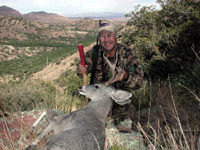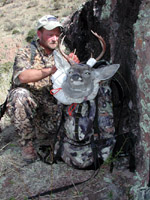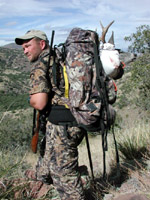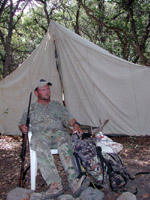
|
Features
|
|
|
|
Books
|
|
|
|
Fun & Games
|
|
|
|
Contact Us
|
|
|
John's Journal... Entry 121, Day 2
CHRIS DENHAM OF ARIZONA -- HUNTING COUES DEER
The Equipment You Need to Hunt Coues Deer
 EDITOR'S
NOTE: Chris Denham of Chandler, Arizona, has lived in Arizona for
38 years and started hunting seriously in Arizona when he was about 14.
Denham, an outfitter and expert hunter, took his first Coues deer when
only 16-years old. A colonel, Elliott Coues, back in the 1800s, first
discovered the Coues deer, and the deer were named after him. This week
we'll take a trip with Denham to the mountains of Arizona to hunt Coues
deer.
EDITOR'S
NOTE: Chris Denham of Chandler, Arizona, has lived in Arizona for
38 years and started hunting seriously in Arizona when he was about 14.
Denham, an outfitter and expert hunter, took his first Coues deer when
only 16-years old. A colonel, Elliott Coues, back in the 1800s, first
discovered the Coues deer, and the deer were named after him. This week
we'll take a trip with Denham to the mountains of Arizona to hunt Coues
deer.
QUESTION: How do you hunt Coues deer?
ANSWER: My clients and I hunt mostly by spotting and stalking -- where
we set up binoculars on tripods and glass for the deer. A Coues deer hunt
is primarily an optics hunt. Quality binoculars and spotting scopes like
those made by Kahles and Swarovski will help you see and take more deer.
 QUESTION:
In what kinds of places do you set up your tripod to glass for deer?
QUESTION:
In what kinds of places do you set up your tripod to glass for deer?
ANSWER: We'll set up on a point of a mountain where I can watch a valley
and the face of a mountain across the valley. Climbing to great heights
isn't always necessary to be able to glass a large expanse of land. This
morning we weren't really that high, although we did have to climb high
to get a great vantage point to see a lot of the country. You have to
watch the sun and realize where the sun will come up in the morning and
where it will set in the evening. Then the sun won't be right in your
face when you want to glass a canyon. You want the sun coming up on either
your left or your right but not directly on the face of the mountain you
want to glass.
QUESTION: That way the deer's back will shine, right?
ANSWER: Yes, the deer's back will shine, especially when his back has
any angle into the sun. My favorite time of day is around 10:00 in the
morning when the sun has risen just enough so that it flashes off the
tops of the deer's backs.
QUESTION: Tell me about the tripod you use. Why do you
use a tripod?
ANSWER: The correct tripod is critical for a couple of reasons when you're
hunting Coues deer. First of all, when the binoculars are on a tripod,
you don't sense any movement except what's out there in nature. Your hands
and your body won't move. Since the binoculars are rock-steady, if something
moves -- even a bird a mile away -- you can spot see it. Only 1% of your
vision (about the size of a nickel) is actually in pure focus at any one
time. When you hold binoculars up to your face with your hands and move
around the mountain looking for deer, you're only looking at 1% of the
entire field of view in that binocular. But when you have the binoculars
on a tripod, the tripod enables you to incorporate 95% of your vision,
which the rods and the cones in your eye are designed to do, and pick
up movement. If you've ever watched a deer in the field, when that deer
sees something, it whips its head around and holds its head perfectly
still. You never see a deer waving its head around as the deer looks up
and down a hillside. The deer looks and holds its head perfectly still
to incorporate its entire eye.
 QUESTION:
Tell me about the particular tripod that you use.
QUESTION:
Tell me about the particular tripod that you use.
ANSWER: This lightweight tripod, specifically made for this type of mountain
hunting, is from the Outdoorsmans in Phoenix, Arizona. The tripod, which
has super-tight tolerances, contains only parts made of machined aluminum.
By machining the aluminum as opposed to using cast parts like most tripods
do, this tripod is very light weight. The one we're using weighs just
over a pound, yet it can support a 53-ounce spotting scope on it.
QUESTION: And this tripod is made by the same people
who make aerospace parts, right?
ANSWER: We gave the machinist who designed this our ideas. Then he was
the one who actually put them on a computer and turned them into reality.
QUESTION: And this Outdoorsmans tripod sells for what?
ANSWER: For $329.00.
QUESTION: Explain again why this tripod is worth so much.
ANSWER: The quality and the manufacturing of this tripod makes it worth
so much. The tolerance is so tight that this tripod won't fall apart.
All the screws are coiled in to keep them from backing out on you. The
only tripod that comes close to the Outdoorsmans tripod is one that has
carbon fiber legs but cast body parts. This other tripod weighs almost
twice as much the Outdoorsmans and cost twice as much too, about $700.
 QUESTION:
What kind of binoculars are you putting on top of that tripod?
QUESTION:
What kind of binoculars are you putting on top of that tripod?
ANSWER: At some time during the hunt for Coues deer, I'll use all the
binoculars I carry with me. I carry an 8X and a 10X Swarovski or Kahles
binocular with me and wear one around my neck and put the other in my
pack. I can put these binoculars on the tripod if I am looking at the
countryside about 600 or 800 yards away. That lower power gives me a much
wider field of view. Then I don't have to move the tripod near as much.
If I'm looking over 800 yards, then I put the Swarovski 15X56 ER on the
tripod.
QUESTION: What is the cost of this binocular?
ANSWER: $1649 retail right now.
QUESTION: Why do you use such expensive binoculars?
ANSWER: Well, the more expensive binoculars have better resolution or
clarity. This resolution includes how clear the binocular is, and how
well you can resolve the images you're seeing. When you get a good look
at some Coues deer in the shade, you'll learn just how critical that color
contrast or resolution is to pull the deer out of the background so that
you can see the deer where it's standing against the forage. Then you
actually can differentiate the deer from the rock. A second point about
these quality binoculars is their brightness during the critical first
1/2-hour and the last 1/2-hour of the day. All Swarovski lenses are multi-coated.
All the binoculars deliver 99.8% light transmission. So when you use these
binoculars by Swarovski, you have phenomenal color and clarity.
QUESTION: Chris, to get your equipment to where you'll
look for these Coues deer, you have a specially-designed backpack. Please
tell me about that.
ANSWER: Badlands, a company from Salt Lake City, Utah, is the company
that makes these backpacks. This company got its start in the mountaineer
business, before deciding the company wanted to make backpacks for hunting.
Some of the folks in the company couldn't find packs they felt could carry
their hunting equipment properly. The main problem with the hunting backpacks
on the market was that they weren't designed correctly. So, Badlands began
making their own hunting packs. Basically they took the mountaineer packs
they already had and made them in camouflage. From there, they specifically
built packs for the hunting market. The Badlands backpacks are ergonomically
designed to fit your hips. The belts pull the weigh in close to your body,
causing the weight of this pack to ride on your hips instead of your having
to carry that weight on your shoulders. Everything is stitched with Kevlar.
QUESTION: So the important thing about a pack is that
the weight is carried on your hips and not on your shoulders?
ANSWER: Exactly. You don't want to put stress on your shoulders and back.
QUESTION: Another piece of equipment that you carry is
a walking stick. Tell me about the walking stick. Why do you carry a walking
stick?
ANSWER: A walking stick first of all gives you a level of confidence.
My hunting pack typically will weigh 35 to 40 pounds on a day hunt. If
you have 40 pounds hanging above your waist that you're not accustomed
to carrying, the walking stick gives you a leverage point high up on your
body. Then you can catch your balance as you're moving through this country.
This country where you're hunting Coues deer will have lots of football-sized
rocks and loose shale all over the place, which makes stumbling easy.
A walking stick will give you another point of stabilization.
QUESTION: You're wearing Mossy Oak's Treklite, which
is extremely light. Are you wearing that clothing because although the
mornings out here can be very cool, then later on in the day the weather
may be really hot?
ANSWER: Exactly. In the mornings, the weather is cool. When you start
hiking up those hills, the weather may be 30 degrees, but you can literally
hike without a shirt on and still sweat. So having a material that wicks
the moisture off your body fast and then dries extremely quick is nice.
You don't want to be up in the mountains with a soaking-wet shirt for
an hour when the wind is blowing as hard as it has been this morning.
You can literally get hypothermia on a 45-degree morning if you're outdoors
with a wet shirt.
QUESTION: The last piece of equipment we will talk about
is the sleeping bag. You need to have a good place to sleep when you hunt
hard all day. Tell me why you've chosen the type of sleeping bags that
you have.
ANSWER: The thing I love about the Butler sleeping bags is that they primarily
have a four-layer system in them. You can crawl into the top layer during
a warm night. You can go down another layer on cooler nights. And then
you can move all the way down to a bottom layer around zero degrees and
sleep outside with this bag. As you've mentioned, sleep is absolutely
critical when you're working this hard during the day. You must get a
good night's sleep. And the key to getting a good night's sleep is to
be comfortable.
To learn more about Coues deer hunting, you can contact Chris Denham at 1814 West Oriole Way, Chandler, AZ 85248, (480) 857-3057, or email him at c.denham@prodigy.net. For information about Denham's equipment, contact: Badlands in Salt Lake City, Utah, for backpacks at (800) 269-1875 or go to www.badlandspacks.com; Butler Bags in Cedar City, Utah, for sleeping bags at (800) 922-2247 or visit www.butlerbags.com; Kahles in Cranston, Rhode Island, for binoculars at (800) 426-3089; Outdoorsmans in Phoenix, Arizona, for Denham's tripod at (800) 291-8065 or go to www.outdoorsmans.com; Swarovski Optik in Barrington, Rhode Island for binoculars at (401) 245-4461; Mossy Oak's Treklite in West Point, Mississippi, at (800) Mossy Oak or www.mossyoak.com.
TOMORROW: HOW THE HUNT FOR THE COUES DEER PROGRESSES
Check back each day this week for more about Hunting Coues Deer...
Day 1 - Acquainting Yourself
With the Area Where You Hunt Coues Deer
Day 2 - The Equipment You Need to Hunt Coues
Deer
Day 3 - How the Hunt for the Coues Deer Usually
Progresses
Day 4 - Another Way to Hunt Coues Deer
Day 5 - Denham's Toughest Coues Hunt and
General Information about Applying to Hunt Coues Deer